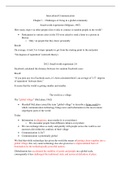Intercultural Communication
Chapter 1 – Challenges of living in a global community
Small world experiment (Milgram, 1967)
How many steps (via other people) does it take to connect to random people in the world?
• Participants in various cities in the US were asked to send a letter to a person in
Boston
o Only via people that they knew personally
Result:
On average, it took 5 or 6 steps (people) to get from the starting point to the end point
“Six degrees of separation” (network theory)
2012: Small world experiment 2.0
Facebook calculated the distance between two random Facebook users
Result:
“If you pick any two Facebook users, it’s been calculated there’s an average of 3.57 ‘degrees
of separation’ between them.”
It seems that the world is getting smaller and smaller.
The world as a village
The “global village” (McLuhan, 1962)
• Marshall McLuhan coined the term “global village” to describe a future world in
which communication technology brings news and information to the most remote
(afgelegen) parts of the world
Today
• Information is ubiquitous; mass media (it is everywhere)
o We encounter people from different cultures everywhere
• We can exchange ideas as easily and quickly with people across the world as our
ancestors did within the confines of their village
• Communication is 24/7
• Communication is potentially global
We find that while technology has given the world the means of getting closer together into a
global village, this very same technology has also given rise to unprecedented fears of
domination by the technologically powerful nations.
Globalization has accelerated the mobility of goods and people on a global scale,
consequently it has challenged the traditional static and universal definition of place.
, Why is it important to gain knowledge about intercultural communication?
• Every person can communicate with people around the globe in lots of different
situations
• But we are not all the same!
• We can anticipate how other people behave and communication is useful; it helps us
help other people
Influence of our own cultural perspective
• Language
• Communication style (formal/informal etc.)
• Value orientations
Globalization
“Globalization is the process of interconnectedness between societies, so that events in one
place of the world have more and deeper effects on people and societies faraway.”
“Globalization is the widening, deepening, and speeding up of worldwide interconnectedness
in all aspects of contemporary social life. This interconnectivity breaks down the boundary
between East and West.”
Connection between cultures and the mass migration of people have a long history; the advent
of communication technologies has just accelerated the process
Globalization in Business
“Globalization in business is the increase of trade around the world, especially by large
companies producing or trading goods in many different countries.”
“Globalization in business is the idea that the world is developing a single economy and
culture as a result of improved technology and communications and the influence of very
large multinational companies.”
Do we live in a unified world?
• KOF Index of globalization
o Economic globalization: trade & investment flows, import/export
o Social globalization: personal contact, information flows, number of Mac
Donalds restaurants, IKEA stores, etc.
o Political globalization: foreign embassies in a country, membership of
international organizations, participation in UN missions, involvement in
international trade agreements
,KOF Index: 1990 – 2017
Views of Globalization
Three perspectives
• Globalists: globalization is an inevitable development, cannot be resisted or
significantly influenced by humans
• Traditionalists: most economic and social activity is regional, rather than global,
the entire world is not interconnected and they don’t want that to happen either; they
still see a significant role for nation-states
• Transformationalists: significant shift; there is more interconnectiveness, but they
question the inevitability of its impacts; there is still significant scope for national,
local and other agencies
Globalization = Diversity or Uniformity?
Is globalization leading to a more diversified or a more uniform world?
Where do we see greater diversity as a result of globalization and where do we see more
uniformity?
, Global cultural diversity
• Today, there are about 5000 distinct
languages and cultures
• The languages/cultures represent at least
300 distinct phyla, i.e., distinct
ethnologinguistic families like Indo-European,
Sinitic, Austronesian, etc.
There has always been (biological) diversity.
Once humans evolved and started associating
with each other, cultural diversity (languages,
rituals) formed as well
The diversity of languages (black dots) strongly correlates to areas of high plant diversity
(darker colours)
• Environmental factors
o Geographical barriers (rivers, mountais) encourage divergence
o Tropical climates support more life; environmentally speaking better to live in
• Sociocultural factors
o Smaller groups tend to be highly adaptable to situations
o Multilingualism (diversity in languages) is the global norm





